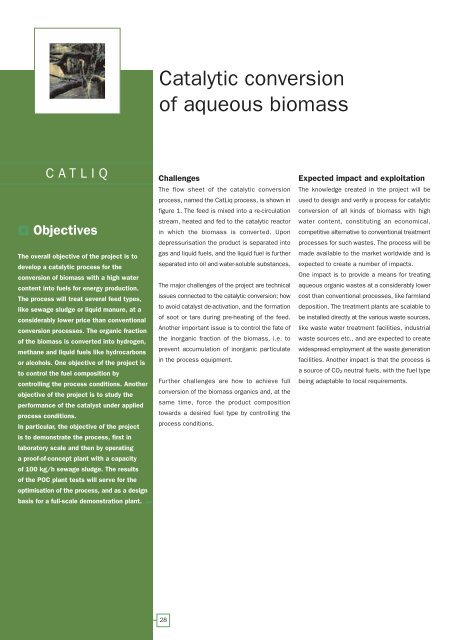European Bio-Energy Projects
European Bio-Energy Projects
European Bio-Energy Projects
Create successful ePaper yourself
Turn your PDF publications into a flip-book with our unique Google optimized e-Paper software.
CATLIQ Challenges<br />
Objectives<br />
The overall objective of the project is to<br />
develop a catalytic process for the<br />
conversion of biomass with a high water<br />
content into fuels for energy production.<br />
The process will treat several feed types,<br />
like sewage sludge or liquid manure, at a<br />
considerably lower price than conventional<br />
conversion processes. The organic fraction<br />
of the biomass is converted into hydrogen,<br />
methane and liquid fuels like hydrocarbons<br />
or alcohols. One objective of the project is<br />
to control the fuel composition by<br />
controlling the process conditions. Another<br />
objective of the project is to study the<br />
performance of the catalyst under applied<br />
process conditions.<br />
In particular, the objective of the project<br />
is to demonstrate the process, first in<br />
laboratory scale and then by operating<br />
a proof-of-concept plant with a capacity<br />
of 100 kg/h sewage sludge. The results<br />
of the POC plant tests will serve for the<br />
optimisation of the process, and as a design<br />
basis for a full-scale demonstration plant.<br />
Catalytic conversion<br />
of aqueous biomass<br />
The flow sheet of the catalytic conversion<br />
process, named the CatLiq process, is shown in<br />
figure 1. The feed is mixed into a re-circulation<br />
stream, heated and fed to the catalytic reactor<br />
in which the biomass is converted. Upon<br />
depressurisation the product is separated into<br />
gas and liquid fuels, and the liquid fuel is further<br />
separated into oil and water-soluble substances.<br />
The major challenges of the project are technical<br />
issues connected to the catalytic conversion; how<br />
to avoid catalyst de-activation, and the formation<br />
of soot or tars during pre-heating of the feed.<br />
Another important issue is to control the fate of<br />
the inorganic fraction of the biomass, i.e. to<br />
prevent accumulation of inorganic particulate<br />
in the process equipment.<br />
Further challenges are how to achieve full<br />
conversion of the biomass organics and, at the<br />
same time, force the product composition<br />
towards a desired fuel type by controlling the<br />
process conditions.<br />
28<br />
Expected impact and exploitation<br />
The knowledge created in the project will be<br />
used to design and verify a process for catalytic<br />
conversion of all kinds of biomass with high<br />
water content, constituting an economical,<br />
competitive alternative to conventional treatment<br />
processes for such wastes. The process will be<br />
made available to the market worldwide and is<br />
expected to create a number of impacts.<br />
One impact is to provide a means for treating<br />
aqueous organic wastes at a considerably lower<br />
cost than conventional processes, like farmland<br />
deposition. The treatment plants are scalable to<br />
be installed directly at the various waste sources,<br />
like waste water treatment facilities, industrial<br />
waste sources etc., and are expected to create<br />
widespread employment at the waste generation<br />
facilities. Another impact is that the process is<br />
a source of CO2 neutral fuels, with the fuel type<br />
being adaptable to local requirements.

















